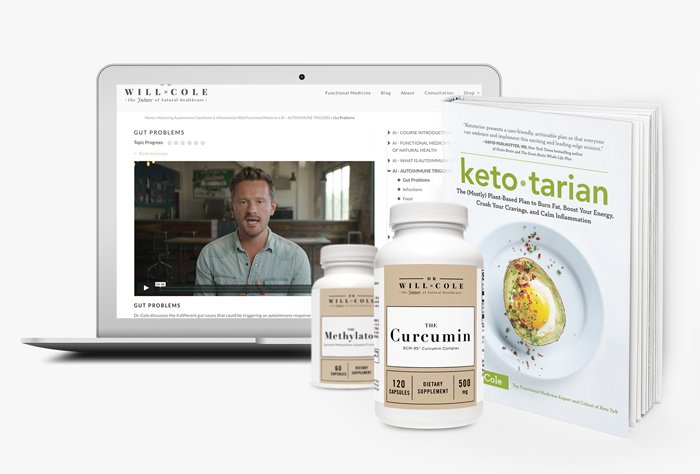Ketotarian Diet: The Cutting- Edge Mostly Plant-Based Keto Food Plan

I have spent years treating patients for their health issues, and I have witnessed firsthand just how powerful food can be in either fueling disease or facilitating optimal health. I have watched the fallout from trendy diets that failed those who followed them, and I have watched some of them succeed temporarily, but ultimately fail. This is why I believe it’s time to dump diet dogma and food fads for good. Instead, let’s put together a realistic, science-based plan that will help your body thrive, even as we live in an age when the incidence of chronic health problems continues to skyrocket.
The Inflammation Age
Before we begin constructing a sensible dietary strategy that can work for you, let’s consider what our goals will be. One of the most important, in my experience, is to address something that is probably happening inside of you, standing in the way of your optimal health. At the root of almost all modern-day health problems, including heart disease, cancer, autoimmune conditions, and even stubborn weight loss resistance, is inflammation. This is one commonality we can not only pinpoint, but that we can actually do something about.
Inflammation is a serious problem in the modern world. Here is some scary evidence:
Article continues below
Make Your Life a Cleanse
SUBSCRIBER-ONLY GUIDES FOR GUT HEALTH, VIBRANT ENERGY, HEALTHY FOOD & CLEAN ALCOHOL
Get FREE access to these + giveaways, recipes, & discount codes in personal emails from Dr. Will Cole.
- An estimated 50 million Americans have an autoimmune condition, and that is not including the millions more that are on the autoimmune-inflammation spectrum but don’t have a diagnosis.
- Someone has a heart attack every 34 seconds.
- One in two men, and one in three women, will be diagnosed with cancer at some point in their lives.
All these health problems are now common, but they should certainly not be considered normal. It’s important to understand that these dangerous health problems don’t just pop up out of nowhere one day. No, they start with the slow burn of inflammation, which is likely to be mostly if not completely unnoticeable at first. This brewing inflammation storm can continue on for years, and as you go on about your life, you may have no idea that you are being subtly and slowly pushed towards developing a full-blown chronic disease.
What does all this have to do with your diet? Plenty! There are many ways we can influence that internal inflammation storm, and what we choose to eat is one of the most obvious and easiest ways to combat the storm and restore our bodies to a state of normal, healthy functioning.
Meet the ketotarian diet
There are many different ways to eat, and different people respond differently to various foods. That’s one reason why so much of the diet dogma seems contradictory. But here’s something that we know: Plant foods, especially vegetables, are disease fighters in multiple important ways. At the same time, we also know that a high-carbohydrate diet, especially when made up mostly of refined grains and sugars, increases inflammation. Finally, we know that healthy fats are important for brain health and fat burning. How do we combine all three of these features into one sensible dietary plan? My answer: Ketotarian.
At its essence, a ketotarian diet is a plant-based version of the trendy ketogenic diet, which has been shown to enhance brain function and stabilize blood sugar (1) by providing your body (2) with a more effective and sustainable form of energy (ketones) instead of quick-burning glucose from carbs and sugar. The beauty of the ketotarian diet is that it takes the benefits of the ketogenic diet, but emphasizes natural whole plant foods. What’s my beef with ketogentic diets? The conventional ketogenic diet can be extremely heavy in meat and dairy and doesn’t take into account the sensitivities that many people have to these foods—not to mention, it can ostracize anyone who would rather follow a more plant-based diet. Also, too much meat and dairy, especially lower quality or industrially produced versions, can be inflammatory.The ketotarian diet, on the other hand, leverages all of the benefits of eating a high-fat diet without the often-inflammatory effects of dairy (3) and conventional, processed meats (which have been linked (4) to cancer when consumed in high amounts). It’s keto for everyone.
So why not just eat vegan or vegetarian? The ketotarian diet not only beats the conventional ketogenic diet for anti-inflammatory power, but also avoids the common mistakes I see many well-intentioned vegans and vegetarians making. At their core, totally plant-based diets can lead to more environmentally friendly eating habits and can have intensive detoxification properties, (5) help fight cancer, (6) and also keep blood sugar under control. (7) However, in my clinic, as with the ketogenic diet, people often don’t practice these diets in the best way. I see far too often that many vegetarians and vegans live on bread, pasta, and other grains, along with beans and soy for protein, with barely a vegetable in sight. They have become, essentially, “carbotarians,” and the result over time can be severe deficiencies of vital nutrients, as well as dangerous levels of inflammation.
The ketotarian diet makes it easier to create a plant-based food plan that’s full of healthy fats, clean protein, and colorful, nutrient-dense vegetables without all the dangers and nutritional mistakes of these other trendy diets. Since it’s low-carb, moderate protein, and high fat, you’re able to transition your body from a sugar burner to a fat burner and put your body into a state of ketosis—just like a conventional ketogenic diet, but with that anti-inflammatory, antioxidant-rich plant-based twist. The healthy, plant-based fats I recommend can be found in foods like coconuts, avocados, olives, and nuts. The best sources for ketotarian protein are seeds and nuts (not soy, which can cause hormone disruption) and legumes (with their gut-irritating lectins). Finally, carbs come not from starchy grains but from low-carb, nutrient-dense non-starchy vegetables like dark leafy greens.
For those who want to truly geek out, in my new book, Ketotarian, I share all the cool science-y details of a plant-based ketogenic diet. But the basic principles are simple:
- Eat real food.
- Keep your carbs low.
- Keep your healthy fats high.
- If you eat a non-starchy vegetable, add some healthy fats.
- If you eat a healthy fat, add some non-starchy vegetables.
- Eat when you are hungry
- Eat until you are satiated, then stop.
Why the ketotarian diet is so good at fighting inflammation
Circling back to inflammation, the ketotarian diet is particularly good at quelling that inflammation storm. Research (8) has shown that specifically eating a high-fat diet devoid of plant fiber actually increases inflammation, but eating fat the ketotarian way means no longer having to worry about diet-caused inflammation. By putting your body into a state of ketosis through a ketotarian diet, you will reduce inflammation by up-regulating the Nrf-2 pathway that is responsible for antioxidant gene induction, as well as turning on genes responsible for the health and function of your detoxification pathways. You’ll also promote healthier cell function. When the Nrf-2 pathway is activated, it calms inflammation and activates the powerful anti-inflammatory cytokine IL-10 (9) and down-regulates pro-inflammatory cytokines.
But that’s just the beginning. When your body switches from burning sugar to burning fat through the production of ketones, you get even more anti-inflammatory benefits. A ketogenic state produces Beta-hydroxybutyrate, which activates the uber-important AMPK (10) pathway to reduce inflammation through inhibiting inflammatory Nf-kB pathways in the body.
All this is a fancy way of saying that putting your body in the fat-burning state of ketosis through natural plant fats specifically soothes inflammation through a variety of biochemical pathways in your body.
Why the ketotarian diet is so good at balancing blood sugar
First, let’s look at sugar consumption: The typical American eats an average of 765 grams of sugar every five days – some of it from obvious sources (sugary coffee drinks, soda, doughnuts, cookies, etc.), but much of it from hidden sources in foods that don’t seem like they could be dessert (soup, salad dressing, condiments, bread). Compare that number to the 45 grams of sugar Americans ate in 1822 over the same 5-day period – that’s a massive increase.
To look at it in another startling way, every person in the U.S. eats and drinks an average of 130 pounds of added sugar every year, which is an average of 3,550 pounds of sugar over a lifetime. To put that in perspective, that is the equivalent of eating 1.7 million Skittles or an industrial-sized Dumpster full of sugar! Yuck. On top of that, most of us base our diets on foods made from grains: bread, pasta, rice, granola bars, cereals, and crackers, which the body also breaks down into – you guessed it – sugar.
Putting aside the startling image of an industrial-sized dumpster of sugar, let’s look at what all this sugar does to your body. Carbohydrates broken down into glucose results in the most easily accessible energy source. When glucose hits your bloodstream, you release insulin to help carry the glucose around your body and deliver it where it is needed. That doesn’t sound so bad, does it? The problem is that most people today eat so much sugar and so many carbohydrates that we end up with blood glucose levels that are dangerously high, since our body doesn’t need nearly that much fuel.
High blood sugar is toxic and it can lead to serious health issues, but in addition, any sugar the body can’t burn gets stored as fat around your liver, stomach, and in circulating fat (known as triglycerides). On top of all that, the by-products of glucose metabolism are inflammatory to the body, especially when there is an excess of glucose. Look at it this way: Burning sugar as your primary source of energy is like using dirty fuel: You have to refuel often (or you will get “hangry” on that blood sugar roller coaster), and the burning of the fuel leaves behind pollution in the form of inflammation.
Fortunately, there is another way. You don’t have to get stuck on the blood-sugar roller coaster, with its erratic peaks and crashes and significant health risks. You don’t have to burn sugar for fuel. Instead, you could be burning fat.
Fat-burning is a more efficient fuel source for your metabolism. A by-product of fat metabolism is ketones, which your body and brain can use as a slow-burning, efficient source of fuel. This allows you to consume far fewer carbohydrates while simultaneously increasing your energy. Less blood sugar means less insulin, and as insulin levels fall and your body requires energy, your liver produces ketones to fuel your body. Your brain can also use ketones as an alternative fuel source when blood levels of ketones are high enough to cross the blood-brain barrier. This is great news because ketones have been shown to be very neuroprotective. (11)
One reaction many people have to this concept is to wonder whether it could possibly be healthy to eat that much fat. Let’s consider some basic facts: Your brain is comprised of 60 percent fat. At birth, many of us relied on fat in the form of breast milk for brain development and energy. And for those who drank formula, MCT oil (derived from coconut and palm oil) is added to most formulas as a source of healthy fats. In order for the brain to work optimally, it needs a lot of energy, and from an evolutionary and biological standpoint, the most sustainable form of energy comes from healthy fats.
A day of ketotarian meals
In practice, there are many ways to practice a ketotarian diet. Here is a possibility for how you might choose to do it, although everyone will have different tastes, preferences, and food tolerances. This is just one example of how I personally practice this way of eating:
Breakfast
Sometimes I practice intermittent fasting and don’t eat breakfast, but when I do, I like to start my day with a fat-loaded smoothie to wake up my brain. My preference is to blend spinach, full-fat coconut milk, a small handful of blueberries, half an avocado for creaminess, and a tablespoon of chia seeds for even more healthy fats and some protein. This smoothie is not just high in healthy plant fats but contains protein and is very low in natural sugar.
Lunch
I love a good zucchini noodle bowl with a homemade olive basil pesto for lunch because it is easy to make ahead and warm up at work. This is a simple yet nutrient-dense lunch.
Dinner
Tacos are my love language, so chances are good that on any given evening, you’ll find me eating some lettuce-wrapped roasted cauliflower tacos for dinner—heavy on the guac and detoxifying cilantro. Yum!
See how simple and delicious this way of eating can be? Overall, ketotarianism is a practical and sustainable dietary strategy that can not only limit cravings and overeating through fat-adaptation (cravings and the compulsion to overeat are two major reasons diets fail), but it also reverses the inflammation storm so your body can work the way it should, unimpeded. Whether you want to be completely plant-based or add in meat every so often (I recommend fatty wild-caught seafood in particular), ketotarian is a great home base. Of course, as with any major dietary shift, it’s important to talk to your doctor to make sure you’re choosing the best foods for your body and health profile.
As one of the first functional medicine telehealth clinics in the world, we provide webcam health consultations for people around the globe.
Photo: unsplash.com
Start Your Health Journey Today
FUNCTIONAL MEDICINE CONSULTATIONS FOR PEOPLE AROUND THE WORLD
References:
- McKenzie AL, Hallberg SJ, Creighton BC, Volk BM, Link TM, Abner MK, Glon RM, McCarter JP, Volek JS, Phinney SD A Novel Intervention Including Individualized Nutritional Recommendations Reduces Hemoglobin A1c Level, Medication Use, and Weight in Type 2 Diabetes JMIR Diabetes 2017;2(1):e5 DOI:10.2196/diabetes.6981
- Nylen K, Velazquez JL, Sayed V, Gibson KM, Burnham WM, Snead OC 3rd. The effects of a ketogenic diet on ATP concentrations and the number of hippocampal mitochondria in Aldh5a1(-/-) mice. Biochim Biophys Acta. 2009;1790(3):208-212. doi:10.1016/j.bbagen.2008.12.005
- Veith WB, Silverberg NB. The association of acne vulgaris with diet. Cutis. 2011;88(2):84-91.
- Jakszyn P, Gonzalez CA. Nitrosamine and related food intake and gastric and oesophageal cancer risk: a systematic review of the epidemiological evidence. World J Gastroenterol. 2006;12(27):4296-4303. doi:10.3748/wjg.v12.i27.4296
- Cobbett C, Goldsbrough P. Phytochelatins and metallothioneins: roles in heavy metal detoxification and homeostasis. Annu Rev Plant Biol. 2002;53:159-182. doi:10.1146/annurev.arplant.53.100301.135154
- Perloy A, Maasland DHE, van den Brandt PA, Kremer B, Schouten LJ. Intake of meat and fish and risk of head-neck cancer subtypes in the Netherlands Cohort Study. Cancer Causes Control. 2017;28(6):647-656. doi:10.1007/s10552-017-0892-0
- Virtanen HEK, Koskinen TT, Voutilainen S, et al. Intake of different dietary proteins and risk of type 2 diabetes in men: the Kuopio Ischaemic Heart Disease Risk Factor Study. Br J Nutr. 2017;117(6):882-893. doi:10.1017/S0007114517000745
- Krishnamurthy VM, Wei G, Baird BC, et al. High dietary fiber intake is associated with decreased inflammation and all-cause mortality in patients with chronic kidney disease. Kidney Int. 2012;81(3):300-306. doi:10.1038/ki.2011.355
- Milder JB, Liang LP, Patel M. Acute oxidative stress and systemic Nrf2 activation by the ketogenic diet. Neurobiol Dis. 2010;40(1):238-244. doi:10.1016/j.nbd.2010.05.030
- Bae HR, Kim DH, Park MH, et al. β-Hydroxybutyrate suppresses inflammasome formation by ameliorating endoplasmic reticulum stress via AMPK activation. Oncotarget. 2016;7(41):66444-66454. doi:10.18632/oncotarget.12119
- Xu K., LaManna J.C., Puchowicz M.A. (2012) Neuroprotective Properties of Ketone Bodies. In: Wolf M. et al. (eds) Oxygen Transport to Tissue XXXIII. Advances in Experimental Medicine and Biology, vol 737. Springer, New York, NY
View More At Our Store
Purchase personally curated supplements
and Dr. Will Cole’s books!

The information on this website has not been evaluated by the Food & Drug Administration or any other medical body. We do not aim to diagnose, treat, cure or prevent any illness or disease. Information is shared for educational purposes only. You must consult your doctor before acting on any content on this website, especially if you are pregnant, nursing, taking medication, or have a medical condition.
Our articles may include products that have been independently chosen and recommended by Dr. Will Cole and our editors. If you purchase something mentioned in this article, we may earn a small commission.

BY DR. WILL COLE
Dr. Will Cole, DNM, IFMCP, DC is a leading functional medicine expert who consults people around the globe, starting one of the first functional medicine telehealth centers in the world. Named one of the top 50 functional and integrative doctors in the nation, Dr. Will Cole provides a functional medicine approach for thyroid issues, autoimmune conditions, hormonal imbalances, digestive disorders, and brain problems. He is also the host of the popular The Art of Being Well podcast and the New York Times bestselling author of Intuitive Fasting, Ketotarian, Gut Feelings, and The Inflammation Spectrum.

Gut Feelings
Healing The Shame-Fueled Relationship
Between What You Eat And How You Feel
